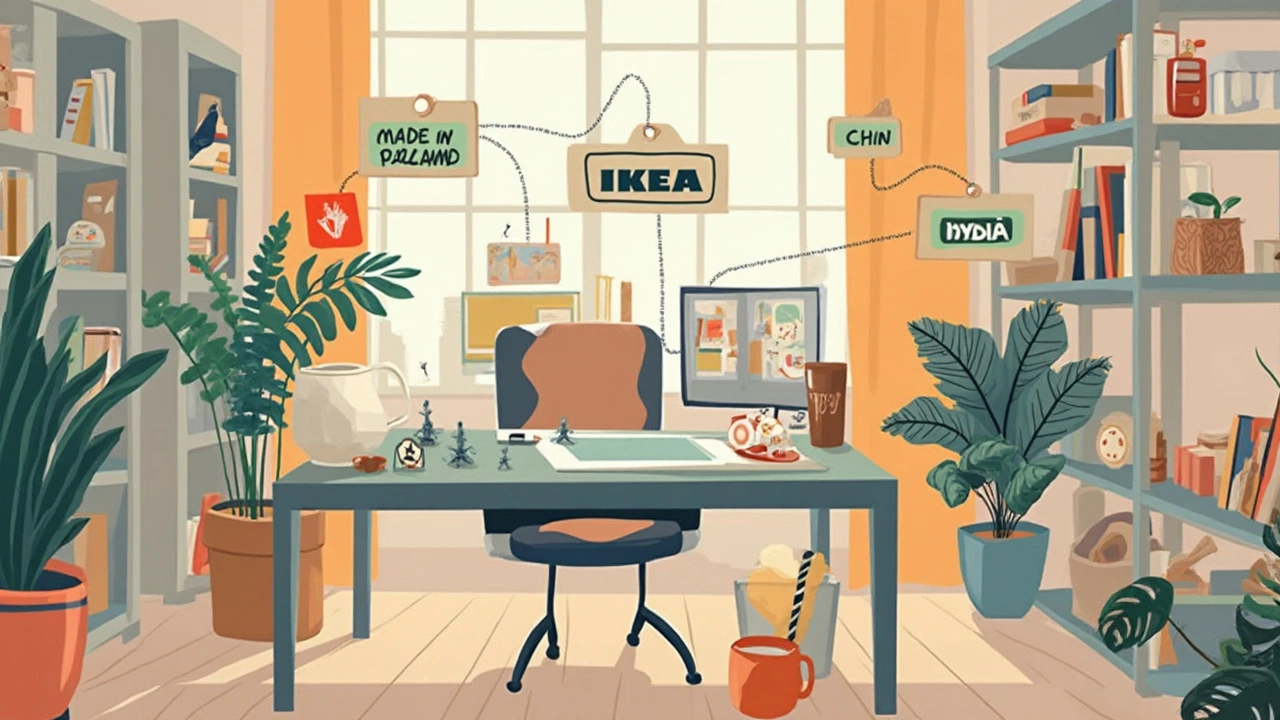Ever flipped over your IKEA Billy bookcase to check where it’s made? Here’s the thing: most people assume IKEA is pure Swedish, but your bookcase probably started its life thousands of miles away. The country on that little white sticker almost never says Sweden. In fact, it’s nearly always Poland, China, or sometimes even Russia—at least before 2022.
This matters for more than just trivia geeks. Where IKEA makes its bookcases can affect what you pay, how quickly you get your shelf, and even how sturdy it ends up being once you lug it home and put it together. If you’ve bought a Billy or Kallax in the last couple of years, you’ve seen prices shift, maybe supply shortages—and that’s not just bad luck. Most of it comes down to where IKEA’s factories are running, and how the global supply chain is doing.
- How IKEA Decides Where to Make Bookcases
- Top Countries Producing IKEA Bookcases
- Why Manufacturing Locations Matter for You
- Best Tips on Choosing Quality IKEA Bookcases
How IKEA Decides Where to Make Bookcases
IKEA's choice of where to make its bookcases isn’t random at all. They look at things like the cost of raw materials, factory wages, shipping distances, and environmental impact. The company is seriously into keeping prices low, so they put their factories in places where wood is cheap, labor is affordable, and transport is straightforward to their biggest markets. That’s why, for years now, you’ll see most bookcase labels saying ‘Made in Poland’ or ‘Made in China.’
Let’s get specific. Poland became IKEA’s go-to country for wood furniture back in the early 2000s. The country has skilled workers, tons of forest, and easy train or truck paths to the rest of Europe. By 2023, Poland was producing about 22% of all IKEA products worldwide, and most of their bookcases roll straight out of Polish factories. China’s another big one, especially for North America since shipping containers packed with Billy or Kallax shelves leave from Chinese ports every day.
IKEA uses a supply chain that stretches across 50+ countries, but just a handful do most of the heavy lifting. Here’s a quick comparison of production by country, using the most recent snapshot available:
| Country | Share of IKEA Global Production (%) | Bookcase Focus? |
|---|---|---|
| Poland | 22 | Yes |
| China | 15 | Yes |
| Germany | 8 | Sometimes |
| Sweden | 4 | Rarely |
| Italy | 3 | Sometimes |
There’s a method to the madness. If you buy in Europe, chances are high your bookcase came from Poland. Buy in the U.S. or Canada? Odds are on China, though Poland still ships a lot across the Atlantic. And lately, IKEA keeps moving some production from Asia back to Europe to dodge supply chain headaches.
- Pro tip: If you want a specific look or material (like oak veneer instead of the usual particleboard), check the sticker before you buy. Where it’s made can change the style and the feel.
Top Countries Producing IKEA Bookcases
If you just bought a Billy or a Kallax, there’s a good chance it didn’t come from Sweden at all. For the last decade, the main countries pumping out IKEA bookcases have been Poland, China, and until recently, Russia. Out of these, Poland completely leads the pack—some years, nearly 20% of all IKEA furniture comes out of Polish factories. China is right there too, especially with smaller accessories and some storage options.
Here’s a breakdown of where most IKEA bookcases are made (figures are estimates based on the latest official company numbers and reports from 2023):
| Country | Share of IKEA's Global Production (%) | Key Products |
|---|---|---|
| Poland | ~20% | Billy bookcase, Kallax shelf, Pax wardrobes |
| China | ~16% | Kallax, Hemnes, smaller bookcases |
| Lithuania | ~6% | Wooden bookcases, components |
| Czech Republic | ~5% | Particleboard and MDF units |
Poland is literally IKEA’s biggest manufacturing base outside Sweden, and it’s especially true for the big items—think the classic Billy bookcase, which has been mostly made there since the early 2000s. China comes in heavy for storage cubes and budget-friendly models, although quality can sometimes vary more than European-made ones. Lithuania, maybe surprisingly, handles lots of the solid wood models. If you spot a sturdier-than-usual shelf, it might be from there. Czech Republic tends to make a ton of the particleboard parts and chipboard shelves, which turn up in plenty of IKEA's budget lines.
Some countries have dropped off lately; Russia was a big player until 2022 when IKEA pulled out after things heated up politically. Factories in Western Europe, like Germany and Sweden, now focus more on design and logistics than the actual making of furniture.
When you check that sticker next time, you’ll almost always see IKEA bookcases marked from one of these main countries. Knowing where your shelves are made helps explain why some feel different than others, why prices go up or down, and even why certain models are out of stock for months at a time.

Why Manufacturing Locations Matter for You
It’s easy to forget about a factory on the other side of the world when you’re picking out a new bookcase. But the spot where your IKEA furniture gets put together actually makes a difference—sometimes a big one. Let’s break down why it matters if your bookcase comes from Poland instead of China or somewhere else.
First up, different countries have different labor costs, transport times, and even wood sources. That’s not just some business school jargon—it shapes the price tag you see at the store, as well as the quality you get at home. Right now, about 60% of IKEA’s total furniture, including those beloved bookcases, comes out of European countries, mostly Poland. China is still in the top three, but its share has dropped a bit in the last couple of years because of global shipping headaches and trade drama. IKEA doesn’t just pick places by throwing darts; they chase a mix of affordability, skilled workers, and local material sources.
Here’s how major production centers stack up:
| Country | Estimated % of IKEA Furniture Production | Main Products |
|---|---|---|
| Poland | 20-25% | Bookcases, cabinets, shelving units |
| China | 15-18% | Chairs, tables, some storage |
| Italy | 7-8% | Kitchen furniture, sofas |
Now, why should you care? A Billy bookcase made in Poland usually hits shelves faster in Europe because it’s much closer to the main IKEA warehouses. That means fewer supply hiccups and sometimes more stable prices. Furniture from farther away has to travel by sea, which can mean months of delay if there’s a shipping backup. Add to that fuel prices or global events—like the Suez Canal blockage in 2021—and your furniture could get stuck halfway around the world.
- If you want consistent stock and delivery for your next IKEA bookcase, European-made products usually show up faster.
- Some folks swear they notice sturdier shelves from Polish factories—they use a lot of pine and board from local forests.
- Knowing where your bookcase is made helps if you care about eco-footprints—shorter supply chains usually mean less shipping pollution, especially within Europe.
So next time you build that flat-pack bookcase, check the label. Where it comes from just might explain why it feels a little sturdier, shows up on time, or costs a few bucks less than you remember.
Best Tips on Choosing Quality IKEA Bookcases
Not all IKEA bookcases are created equal, and a few smart tricks can make the difference between a wobbly shelf disaster and a reliable home for your stuff. Let’s break down what really works when picking the best IKEA bookcase for your needs.
- Check where it’s made: The country of manufacture can sometimes hint at quality. For example, bookcases made in Poland tend to get good feedback for solid build, while some of the earlier China-made batches have gotten mixed reviews. Always scan that product sticker before you buy.
- Avoid particleboard overload: Most IKEA bookcases use particleboard, but higher-end models sometimes blend in real wood. Look for terms like “solid wood,” even if it’s just for the edges or the back panel.
- Don't overload those shelves: IKEA is famous for the BILLY bookcase, but each shelf can only hold about 30 kg (that’s around 66 lbs). Respect those limits or you’ll end up with saggy shelves.
- Check for extra reinforcement: Some IKEA bookcases offer optional wall anchoring kits. Use them, especially if you’ve got kids or you want extra peace of mind.
According to IKEA’s own website, the BILLY bookcase is produced every three seconds worldwide. That’s a lot of bookcases, and consistency matters. Mark Sparrow, a retail expert interviewed by Forbes, put it simply:
"If you’re buying from IKEA, don’t rush—check the boards for dents, gaps, or warping at the store, and always double-check the hardware pack."
Here’s a quick comparison of popular IKEA bookcases—the kind of info you won’t get by just glancing at tags:
| Model | Main Materials | Origin (2024) | Shelf Max Load (kg) |
|---|---|---|---|
| BILLY | Particleboard, Fiberboard | Poland, Lithuania | 30 |
| KALLAX | Particleboard, Fiberboard | Poland, China | 13 (per cube) |
| HEMNES | Solid Pine, Particleboard | Estonia, Romania | 35 |
One more pro tip: If in doubt, spend a little extra for the HEMNES line. They’re made with more real wood and generally feel sturdier year after year. And whatever you do, don’t forget that anchoring kit. Most accidents happen when tall bookcases tip over, not from worn-out boards.
Choosing the right IKEA bookcase isn’t just about looks—it’s about getting something you can trust. Keep these pointers handy before your next trip to the blue and yellow maze.

